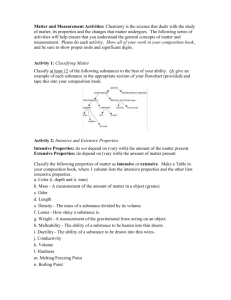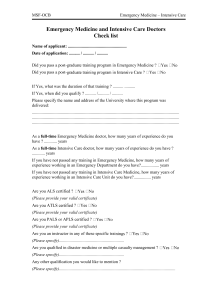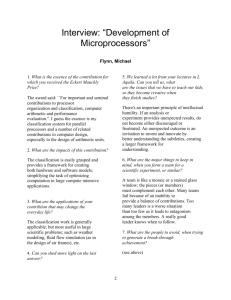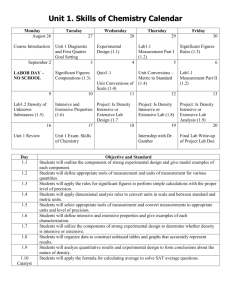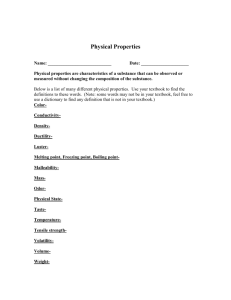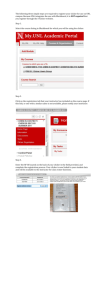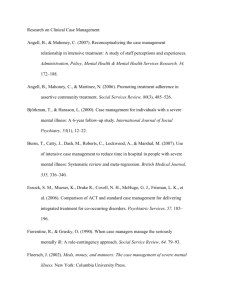Chem 103, Section F0F Unit I - An Overview of Chemistry Lecture 2
advertisement
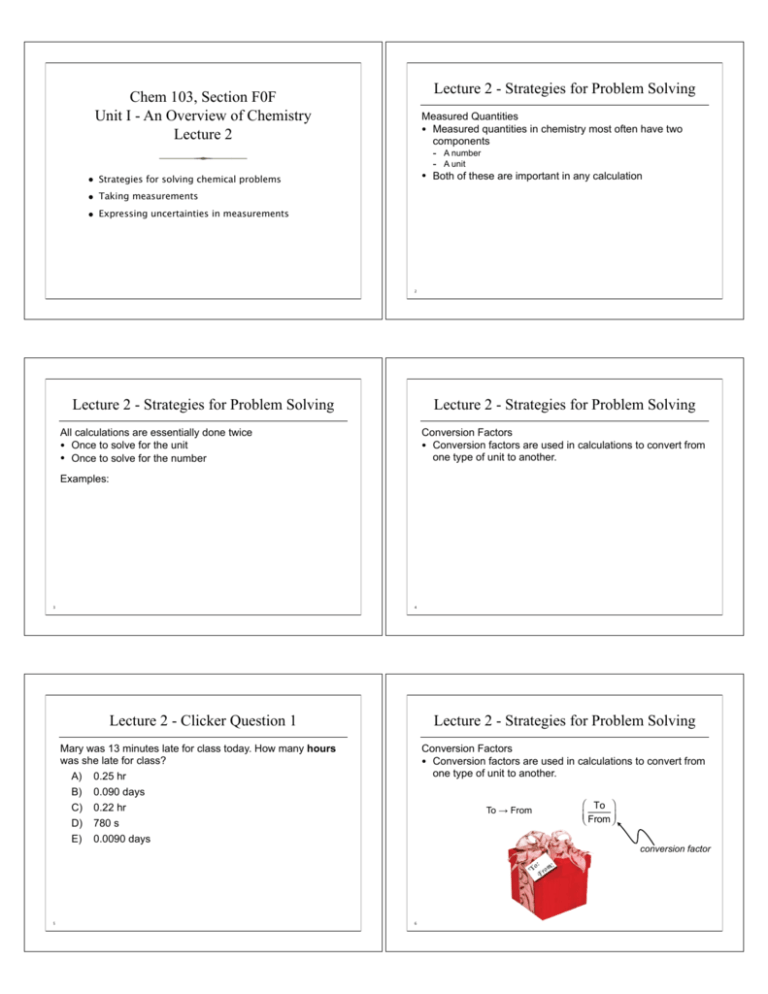
Lecture 2 - Strategies for Problem Solving Chem 103, Section F0F Unit I - An Overview of Chemistry Lecture 2 Measured Quantities • Measured quantities in chemistry most often have two components - A number - A unit • Both of these are important in any calculation • Strategies for solving chemical problems • Taking measurements • Expressing uncertainties in measurements 2 Lecture 2 - Strategies for Problem Solving Lecture 2 - Strategies for Problem Solving All calculations are essentially done twice • Once to solve for the unit • Once to solve for the number Conversion Factors • Conversion factors are used in calculations to convert from one type of unit to another. Examples: 3 4 Lecture 2 - Clicker Question 1 Lecture 2 - Strategies for Problem Solving Mary was 13 minutes late for class today. How many hours was she late for class? A) 0.25 hr B) 0.090 days C) 0.22 hr D) 780 s E) 0.0090 days 5 Conversion Factors • Conversion factors are used in calculations to convert from one type of unit to another. To ! From ! To $ #" From &% conversion factor 6 Lecture 2 - Strategies for Problem Solving Lecture 2 - Clicker Question 2 Conversion Factors • Conversion factors can strung together in longer calculations. Mary was 13 minutes late for class today. How many days was she late for class? A) 0.25 hr B) 0.090 days C) 0.22 hrLecture 2 D) 780 s E) 7 8 Lecture 2 - Strategies for Problem Solving Problems should be solved systematically • Problem • Plan • Solution • Check • Comment • Follow-up Problem (Answers in back of chapter.) 9 10 11 12 0.0090 days 13 14 15 16 Lecture 2 - Measurements Lecture 2 - Measurements We will be using the SI system of units: • There are 7 fundamental units in this system: 17 We will be using the SI system of units: • Metric units are typically scale by factors of 1,000. 18 Lecture 2 - Measurements Lecture 2 - Measurements We will be using the SI system of units: • Conversions from English units 19 Some units are derived from the fundamental units. • Example, the liter 20 Lecture 2 - Measurements Lecture 2 - Clicker Question 3 Some measurements or properties are intensive while others are extensive. Is the following property an intensive or extensive property? Mass? A) Intensive Intensive property • One that is independent of the amount of substance present B) Extensive Extensive property • One that is dependent on the amount of substance present 21 22 Lecture 2 - Clicker Question 4 Lecture 2 - Clicker Question 5 Is the following property an intensive or extensive property? Density? A) Intensive B) Extensive 23 Is the following property an intensive or extensive property? Volume? A) Intensive B) Extensive 24 Lecture 2 - Clicker Question 6 Lecture 2 - Measurements Is the following property an intensive or extensive property? Melting point? A) Intensive B) Extensive Temperature: • The Celsius (°C) and Fahrenheit (°F) scales are the ones commonly used. • We will also be using the Kelvin (K) scale. - Used when discussing thermal energy. 25 26 Lecture 2 - Uncertainty Lecture 2 - Uncertainty When communicating quantities to other, we need to also communicate our confidence in those quantities • Example Significant digits • Express all digits that your are certain about, plus the first digit that you have some uncertainty about. 3.12 ± 0.05 g 27 28 Lecture 2 - Uncertainty Lecture 2 - Uncertainty Significant digits in calculations • Addition and subtraction - Look a decimal places • Multiplication and division - Look at significant figures Precision vs Accuracy Round off at the end of your calculations 29 30 Unit I - Up Next • The chemist’s view of matter: atoms, elements, compounds & mixtures. • Some observations that led to the atomic view of matter • Dalton’s postulates for the atomic view of matter 31 The End
